http://www.wikipaintings.org/en/grandma-moses
Anna Mary Robertson Moses (September 7, 1860 – December 13, 1961), better known as "Grandma Moses", was a renowned American folk artist. She is often cited as an example of an individual successfully beginning a career in the arts at an advanced age. Her family and friends called her either "Mother Moses" or "Grandma Moses", and although she first exhibited as "Mrs. Moses", the press eagerly dubbed her "Grandma Moses", which stuck. LIFE magazine celebrated her 100th birthday by featuring her on its September 19, 1960 cover.
Grandma Moses& paintings were used to publicize numerous American holidays, including Thanksgiving, Christmas and Mother&s Day. Exemplary of her status, a Mother&s Day Feature in True Confessions (1947) noted how "Grandma Moses remains prouder of her preserves than of her paintings, and proudest of all of her four children, eleven grandchildren and four great-grandchildren."
During the 1950s, Grandma Moses& exhibitions were so popular that they broke attendance records all over the world. "A cultural icon, the spry, productive nonagenarian was continually cited as an inspiration for housewives, widows and retirees. Her images of America&s rural past were transferred to curtains, dresses, cookie jars, and dinner ware, and used to pitch cigarettes, cameras, lipstick and instant coffee."
In 1950, the National Press Club cited her as one of the five most newsworthy women and the National Association of House Dress Manufacturers honored her as their 1951 Woman of the Year. At age 88, Mademoiselle magazine named Grandma Moses a “Young Woman of the Year”. Philadelphia’s Moore College of Art awarded her its first honorary doctorate degree. Due to a lingering cold, she received the degree in absentia, presenting her acceptance speech via a special telephone hookup.
Early life
Anna Mary Robertson was born on September 7, 1860, on a farm in Greenwich, upstate New York, one of a family of 10 children. In 1887, at the age of 27, she married a "hired man", Thomas Salmon Moses, and the couple established themselves on a farm in Virginia where they spent nearly two decades. During this time she gave birth to 10 children, five of whom died in infancy. In 1905, the couple returned to New York and settled in Eagle Bridge, not far from Anna Mary&s birthplace. In 1927 her husband Thomas died but she continued to farm with the help of her youngest son until advancing age forced her to retire to a daughter&s home in 1936.
Often, during her younger days as a wife and mother, she had been creative in her home by, for example, using housepaint to decorate a fireboard—but her earliest works used embroidery rather than paint. Her embroidered pictures were much admired by friends and relatives, so when arthritis eventually made it painful to wield a needle, her sister suggested that it might be easier to paint—the pivotal suggestion that spurred her painting career in her late 70s.
Painting
According to art historian Judith Stein, Grandma Moses was "practical at heart, turning to painting in her seventies after working with worsted wools for embroidered compositions", which risked being eaten by moths. She painted mostly scenes of rural life. Others have noted that she abandoned a career in embroidery because of arthritis. Grandma Moses told reporters that she turned to painting in order to create the postman&s Christmas gift, seeing as it "was easier to make [a painting] than to bake a cake over a hot stove." Stein notes that "her sense of accomplishment in her painting was rooted in her ability to make &something from nothing&, as Lucy Lippard defined the aesthetics of women&s &hobby art& in 1978." Stein considers Moses& quilting work, for which she transformed cloth scraps into useful and beautiful objects, akin to hobby art.
Her early style is less individual and more realistic (also known as primitive art), despite her lack of knowledge of (or perhaps rejection of) basic perspective. She did not develop her immediately recognizable signature folk style until later. Many of her early paintings in the realist style were given to family members as thank-you gifts after her visits. She was a prolific painter, generating over 1600 canvasses in 3 decades. Before her fame, she would charge $2 for a small painting and $3 for a large. Her winter paintings are reminiscent of some of the known winter paintings of Pieter Bruegel, the Elder, such as The Hunters in the Snow and Winter Landscape with a Bird Trap.
In 1938 a New York engineer and art collector, Louis J. Caldor, who was driving through Hoosick Falls, saw some of her paintings displayed in a drug store window. They were priced from $3 to $5, depending on size. He bought them all, drove to the artist&s home at Eagle Bridge and bought ten others she had there. The next year, three Grandma Moses paintings were included in "Contemporary Unknown American Painters" at the Museum of Modern Art in New York. She did not remain unknown for long. Her first solo exhibition, "What a Farm Wife Painted", opened October 1940 at Otto Kallir&s New York City gallery Galerie St. Etienne, followed by a meet-and-greet with the artist and an exhibition of 50 paintings at Gimbel&s Department Store November 15, followed by a third solo show in as many months, at the Whyte Gallery, Washington, D.C. "Gimbels had supplemented Moses& art display with a table beneath the paintings spread [with] samples of Grandma&s culinary talents—homebaked bread, rolls and cake, plus some of the preserves which won her prizes at the county fair." This brought her to the attention of collectors all over the world, and her paintings became highly sought after. After her death, large traveling exhibitions circulated throughout Europe and Japan, where her work was particularly well received.
The Bennington Museum in Bennington, Vermont, holds the largest public collection of Moses& paintings in the country, as well as "Yarn paintings", art supplies, and the 18th century tilt-top table Moses painted with rustic scenes and used as her easel.
Her paintings were soon reproduced on Christmas cards, tiles and fabrics in America and abroad. In 1946 her painting The Old Checkered Inn in Summer was featured in the background of a national advertising campaign for the young women&s lip gloss Primitive Red by Du Barry cosmetics. President Harry S. Truman presented her with the Women&s National Press Club trophy Award for outstanding accomplishment in art in 1949, and in 1951 she appeared on See It Now, a television program hosted by Edward R. Murrow. The "See It Now" segment on Grandma Moses, presently available on DVD in "The Edward R. Murrow Collection", unfortunately contains but one-third of the actual 25-minute produced interview. In 1952 she published her autobiography and titled it Grandma Moses: My Life&s History.
On her 100th birthday in 1960, New York Governor Nelson Rockefeller proclaimed the day "Grandma Moses Day" in her honor.
In November 2006, her work Sugaring Off (1943), became her highest selling work at US $1.2 million. The work was a clear example of the simple rural scenes she became known for.
Legacy
A 1942 piece, The Old Checkered House, 1862 was appraised at the Memphis 2004 Antiques Roadshow. The painting was a summer scene in Geneva, New York, not as common as her winter landscapes. Originally purchased in the 1940s for under $10, the piece was assigned an insurance value of $60,000 by the appraiser, Alan Fausel.
Another of her paintings, Fourth of July, was given by Otto Kallir to the White House and still hangs there today.
The character Granny on the popular 1960s rural comedy television series The Beverly Hillbillies was named Daisy Moses as an homage to Grandma Moses, who died shortly before the series began.She is buried in Hoosick Falls, New York.
Norman Rockwell, who, for a time, lived in Arlington, Vermont, was a friend of Grandma Moses who lived in nearby Eagle Bridge, New York. Grandma Moses also appears on the far left edge in the Norman Rockwell painting Christmas Homecoming, which was printed on the cover of the Saturday Evening Post of December 25, 1948.
A U.S. commemorative stamp was issued in her honor in 1969.
(1)Shenandoah Valley, 1938. Naïve Art (Primitivism).
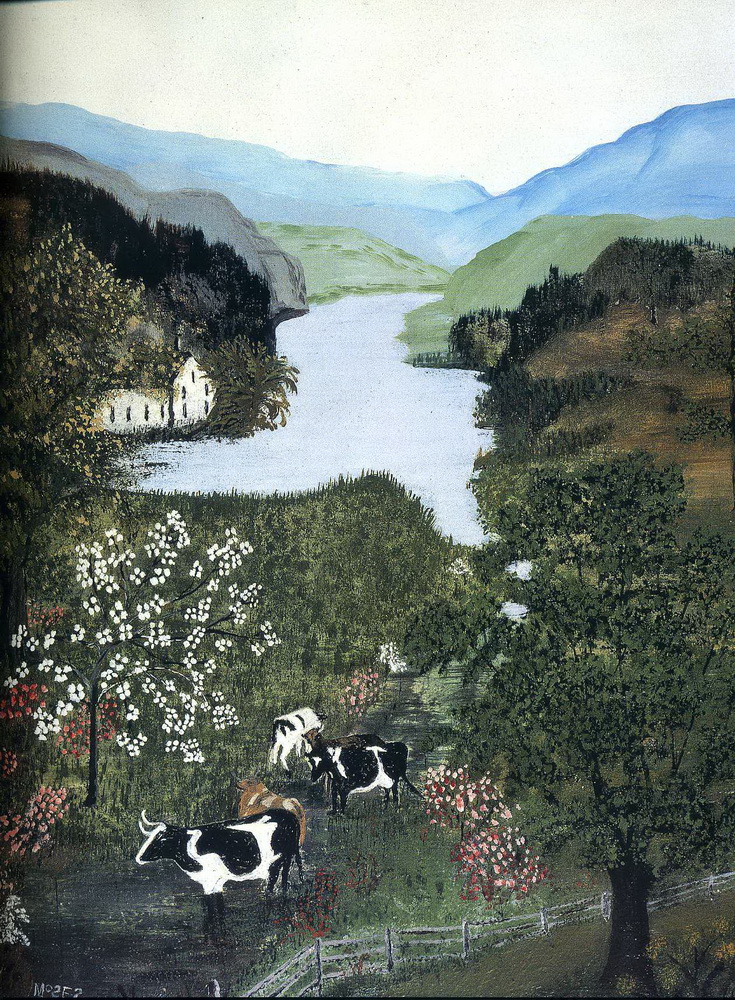
Original Size
(2)Shenandoah Valley (1861 News of the Battle), 1938. Naïve Art (Primitivism).

Original Size
(3)Catching the Turkey, 1940. Naïve Art (Primitivism).
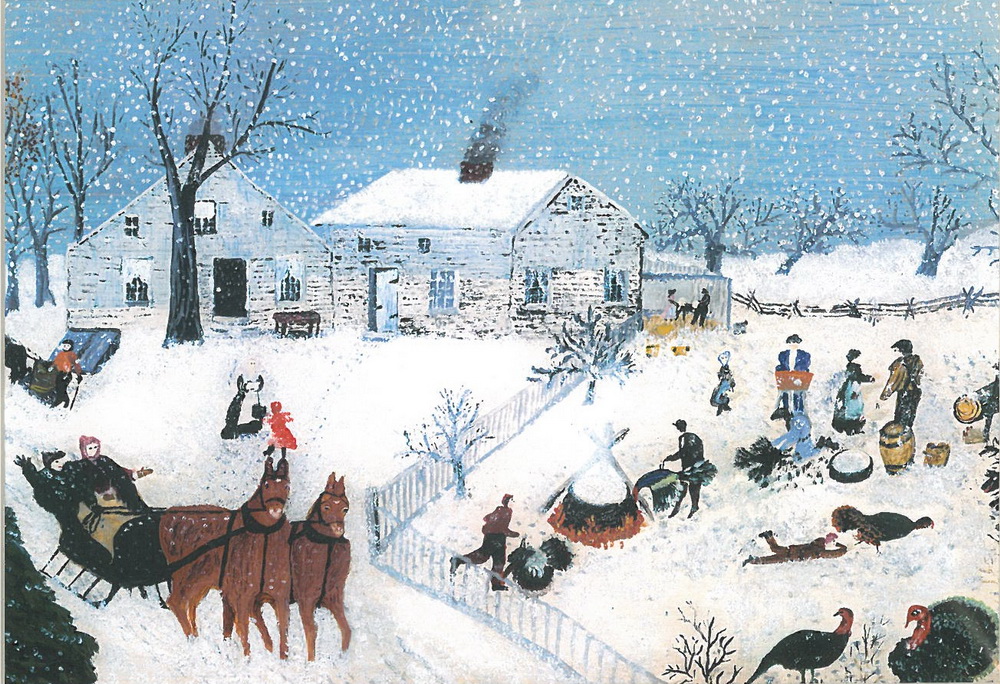
Original Size
(4)The Burning of Troy in 1862, 1943. Naïve Art (Primitivism).
Troy, which lies across the Hudson River from Albany, New York, was the largest city near Grandma Moses& home in Eagle Bridge. Surviving documents suggest that, for a brief period before she married, the future artist did factory work in Troy.
A massive fire in Troy two years after Moses& birth clearly figured prominently in local lore. Moses cut out and saved a commemorative news clipping, published in 1939, and used it as the basis for a series of paintings. The artist&s pencil notations on the clipping indicate how she proposed to modify the vignette. The Burning of Troy in 1862, the fifth version she did of the subject, is already quite far removed from the clipping.
Conventional illustration tends to focus on foreground or background, but seldom on both at once. Combining these two views was one hallmark of the "Grandma Moses" style. Thus, in The Burning of Troy Moses has considerably expanded the scene beyond the burning bridge, including more foreground as well as a detailed rendering of the city in the background.

(5)Sugaring Off, 1943. Naïve Art (Primitivism).
"Sugaring Off" was one of Grandma Moses& most popular themes. Like many of her earliest subjects, it derived from popular illustration—in this case, a well-known Currier & Ives lithograph. Although Moses did at the very start of her career sometimes copy compositions verbatim, she never tried to duplicate this Currier & Ives print. Rather, from the start she freely combined elements from her primary source with vignettes from other sources and from her own imagination. Certain stock images do tend to recur in the "Sugaring Off" paintings, however, among them the burning cauldron, the mother pouring maple sugar on the snow (where it would harden into instant candy), the men with buckets, and the little "sugar house."
Sugaring Off dates from 1943, at the height of Grandma Moses& first truly mature style. She had by this point in her career gained formidable mastery of her medium. She was capable of rendering details with pristine clarity and of handling extremely complex compositions. Sugaring Off is notable for its vast assortment of disparate activities, arrayed in a preternaturally broad landscape. This opening up of the landscape into an almost square, quiltlike panoply of detail is one of the hallmarks of the "Grandma Moses style." As she matured further, however, Moses would revert to narrower horizontals, which required greater compression of detail.

(6)Checkered House, 1943. Naïve Art (Primitivism).
Like the Troy fire, the Checkered House was a local legend. Situated along the Cambridge Turnpike, it was an inn where stagecoach drivers had changed horses as far back as the eighteenth century. During the Revolutionary War, the inn served as General Baum&s headquarters and field hospital. Its checkerboard front made the house a distinctive landmark that was remembered long after it burned in 1907.
Moses painted a number of versions of "Checkered House," in both winter and summer. When asked how she managed to come up with a new composition each time, she said she imagined the scene as if she were looking at it through a window. By then shifting her viewpoint slightly, she could cause the elements to fall into place differently.

(7)Hoosick Falls, New York, in Winter, 1944. Naïve Art (Primitivism).
The Village of Hoosick Falls will always have a key place in the biography of Grandma Moses. It was here that her paintings were first discovered, sitting in Thomas& Drugstore window, and it is here that the artist is buried.
For Moses herself, however, the importance of Hoosick Falls lay not in its connection to her own career, but in the village&s role in American history. Today Hoosick Falls, the closest real town to the Moses farmstead, is a sleepy hamlet, somewhat passed over by modern economic development. However, until the Great Depression, it was a bustling commercial center, its industrial potential bolstered by its situation at the confluence of the Hoosick and Walloomsack Rivers. Moses associated the area, hunting grounds of the Mohican Indian tribe, with the tales of James Fenimore Cooper. "Some say Natty Bumpo sleeps his sleep in an unknown grave in the village limits," she wrote.
Moses painted a number of versions of Hoosick Falls, showing the village in various seasons. Most follow the winding path of the Hoosick River, and may be based in part on old prints of the town. The bird&s-eye view—encompassing more than would be visible from any single human vantage point—is, however, typical of Moses& unique approach.

(8)Early Springtime on the Farm, 1945. Naïve Art (Primitivism).

(9)Wash Day, 1945. Naïve Art (Primitivism).
Many of Moses& earliest paintings had drawn on traditional American themes, such as "Catching the Thanksgiving Turkey" or "Sugaring Off". Moses chose these subjects because they reflected her personal experience, and it was this experience, as well as her keen observation of the surrounding landscape, that gave new life to these relatively dated images. As she grew more artistically confident, however, she began to craft paintings that were based more directly and completely on her own memories. Wash Day is such an image.

(10)Hoosick Valley (From the Window), 1946. Naïve Art (Primitivism).
If Moses took anecdotal vignettes from newspaper and magazine clippings, her painting technique was largely derived from her experiences with embroidery.
Like all women born in the days when store-bought clothes were a rare luxury, Moses had learned to sew in early childhood. Her first sustained pictorial efforts were, perhaps as a result, undertaken not with paint but with yarn. Even after Moses gave up making these embroidered "worsted" pictures, she tended to treat paint like yarn.
Perhaps one of the most salient aspects of working with yarn is that— unlike paint—yarn makes it impossible to blend colors. In order to achieve subtle gradations of hue, multicolored strands must be placed side by side. This way of working translated into what some have characterized as Moses& impressionistic handling of paint. In Hoosick Valley (From the Window), varied tones of green and yellow are set next to one another to evoke the interplay between parched meadows and verdant hills.
Moses also used paint texture in a manner that mimicked embroidery. Fenceposts are "stitched" into place, blossoming trees appear to be rendered in little knots of thread. Moses established a series of textural gradations, from flat expanses and isolated blocks of color to more intricate, multicolored configurations. Certain details were deliberately executed in raised paint in order to set them off from the background. Many of Moses& paintings, when viewed up close, are actually composites of abstract forms.

(11)Country Fair, 1950. Naïve Art (Primitivism).

(12)Morning Day on the Farm, 1951. Naïve Art (Primitivism).

(13)Joy Ride, 1953. Naïve Art (Primitivism).

(14)Christmas at Home. Naïve Art (Primitivism).
Grandma Moses was closely associated with Christmas, in part because for many years Hallmark issued a best-selling line of Moses Christmas cards and in part because that holiday—with its combination of wintry cheer, evergreen trees, and joyful celebration— mirrors many of Moses& own favorite preoccupations.

(15)Winter. Naïve Art (Primitivism).
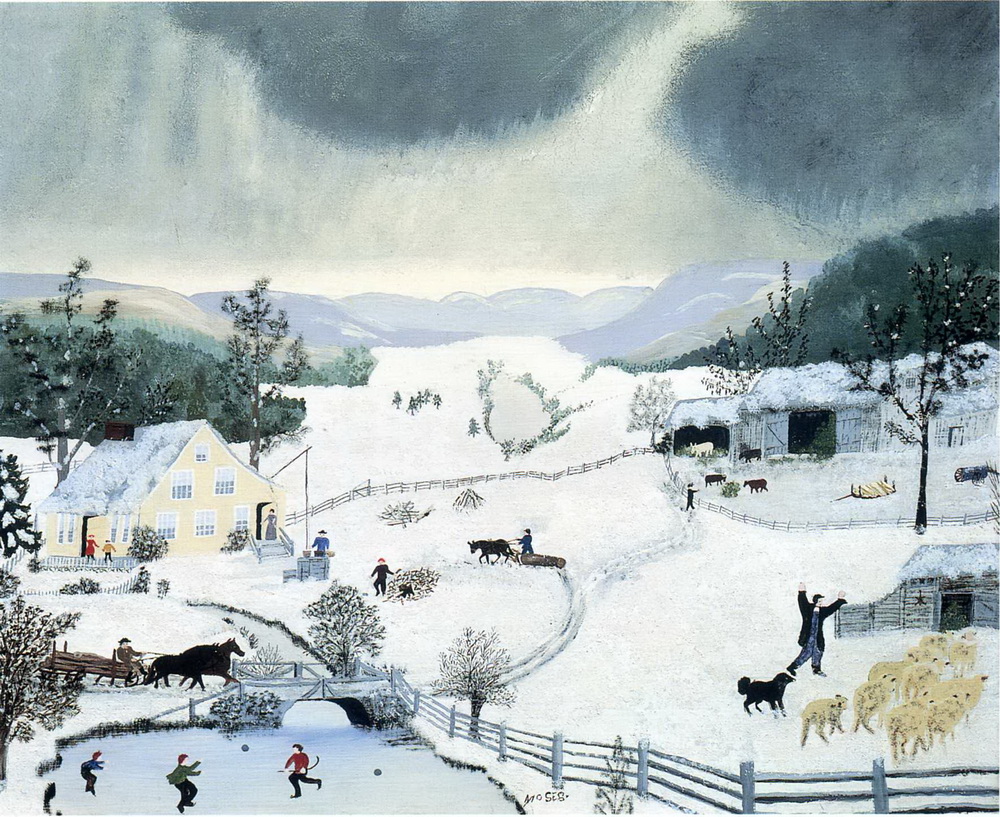
Original Size
(16)So Long Till Next Year, 1960. Naïve Art (Primitivism).
Although Grandma Moses was always open to new challenges, she resisted attempts by outsiders to dictate to her in terms of style or subject matter. "Someone has asked me to paint Biblical pictures," she once noted, "and I say no, I&ll not paint something that we know nothing about; might just as well paint something that will happen a thousand years hence."
Nevertheless, despite her staunch adherence to the factual and true, less than two years before she died Moses acceded to a request to illustrate a children&s book, Clement C. Moore&s famous poem, "The Night Before Christmas." Just as she rose to and ultimately mastered the challenge of painting interiors, Moses—even at the age of nearly 100—was ready to risk something completely untried. Unfortunately, she did not live to see the publication of The Night Before Christmas, which appeared in 1962 and remained more or less continuously in print for the next three decades.
While many of the Night Before Christmas illustrations dutifully follow the text of the poem, So Long Till Next Year is pure fantasy on Moses& part. Not actually published in the original edition of the book, it is nonetheless in many ways the quintessential Christmas painting by an artist who was famous for such subjects. Unlike most of Moses& snowscapes, which are clearly grounded in nature, the blue background of So Long Till Next Year immediately informs us that we are in the realm of the imagination. The scenery is etched on this background in a frosty filigree, like icicles on a window pane. Above all, So Long Till Next Year demonstrates Moses& exceptional flexibility and versatility.

(17)The Rainbow, 1961. Naïve Art (Primitivism).

(18)Halloween, 1955. Naïve Art (Primitivism).

(19)Sugaring Off, 1955. Naïve Art (Primitivism).
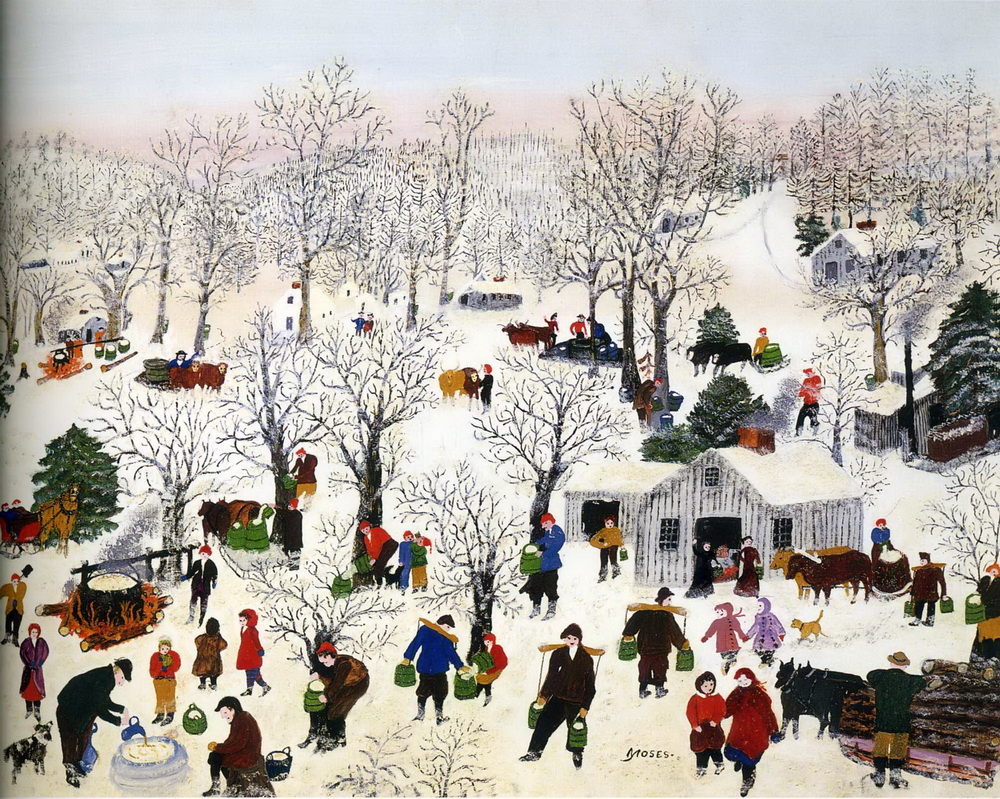
Original Size
(20)Waiting for Christmas, 1960. Naïve Art (Primitivism).
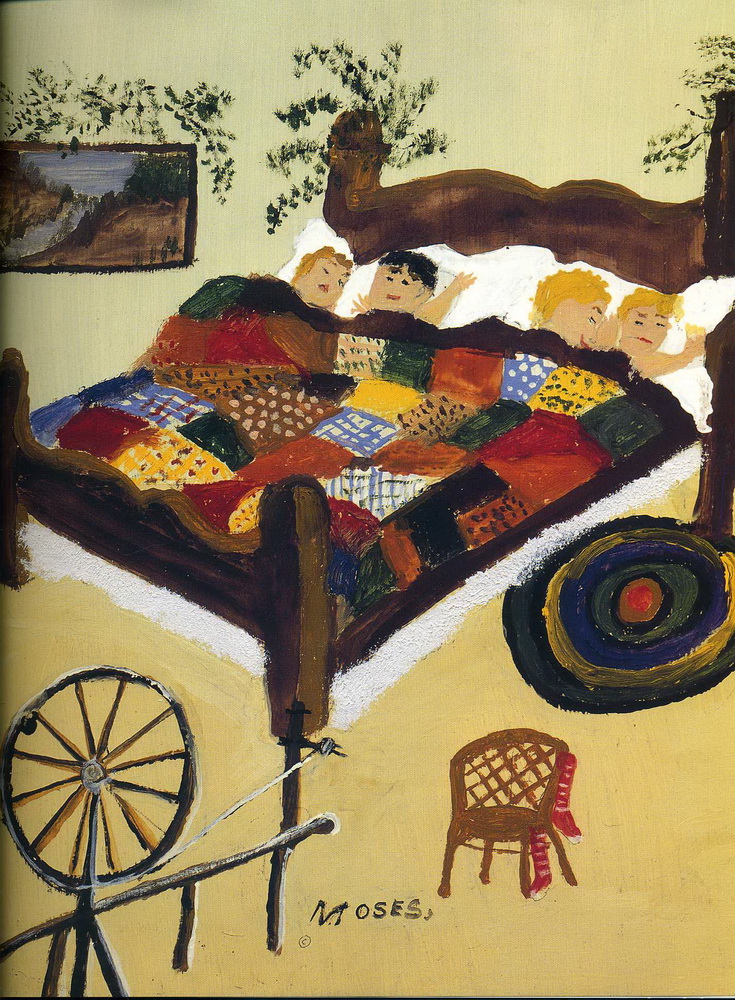
Original Size
(21)The Quilting Bee, Start Date: 1940, Completion Date: 1950. Naïve Art (Primitivism).
Moses was basically a landscape painter, but certain memories and themes demanded an indoor setting. She herself knew this, and some of her patrons encouraged her to expand her repertoire to include interiors. The subject, however, did not come easily to her.
"I tried that interior but did not like it, so I erased it," she noted on one occasion. "That don&t seem to be in my line. I like to paint something that leads me on and on into the unknown, something that I want to see away on beyond. Well, maybe I try again."
Despite her difficulties with the subject, Moses did paint a number of striking interiors. Without the landscape to anchor the scene and provide an element of realism, her interiors rely almost wholly on the artist&s command of abstract form and patterning. These qualities are used to maximum advantage in The Quilting Bee, wherein the colors and forms of the large quilt and the elaborate table setting play off neatly against the bright clothing of the numerous bustling characters. Still, Moses could not resist adding a bit of nature beyond the tall, uncurtained windows.
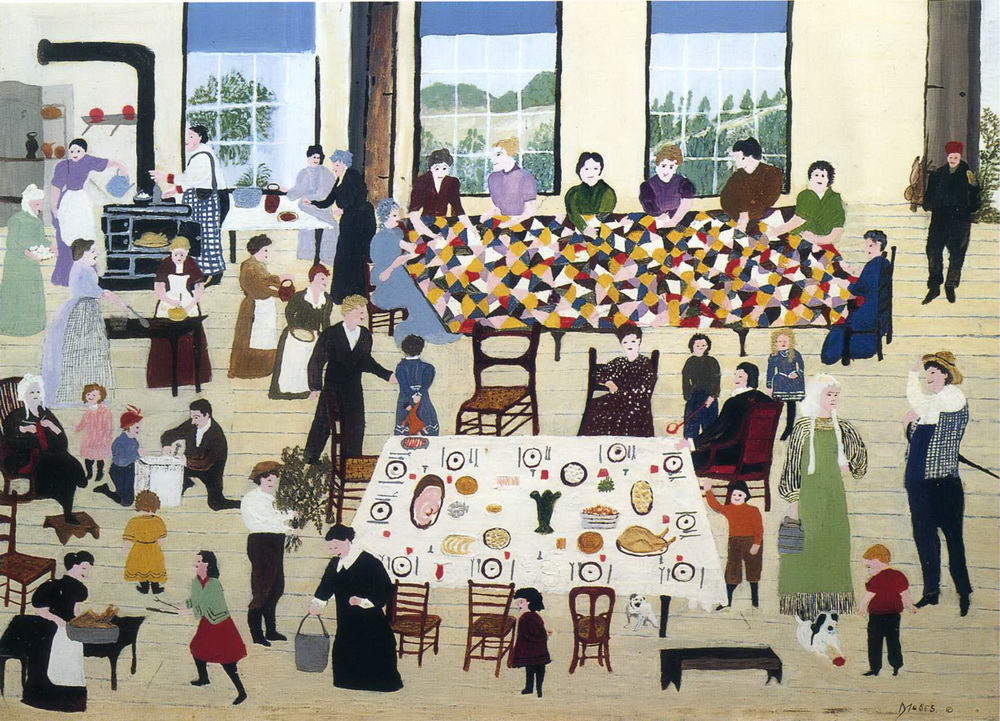
Original Size
(22)Checkered House. Naïve Art (Primitivism) .
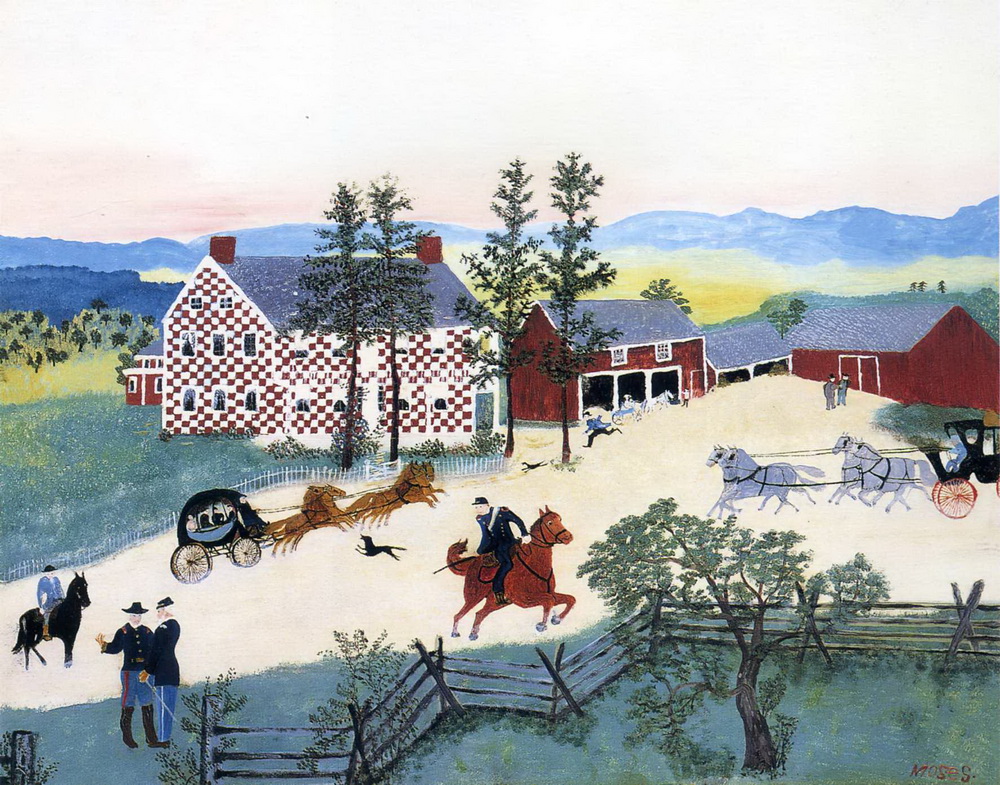
Original Size
(23)Eagle Bridge Hotel, 1959. Naïve Art (Primitivism).

(24)Taking in the Laundry, 1951. Naïve Art (Primitivism).
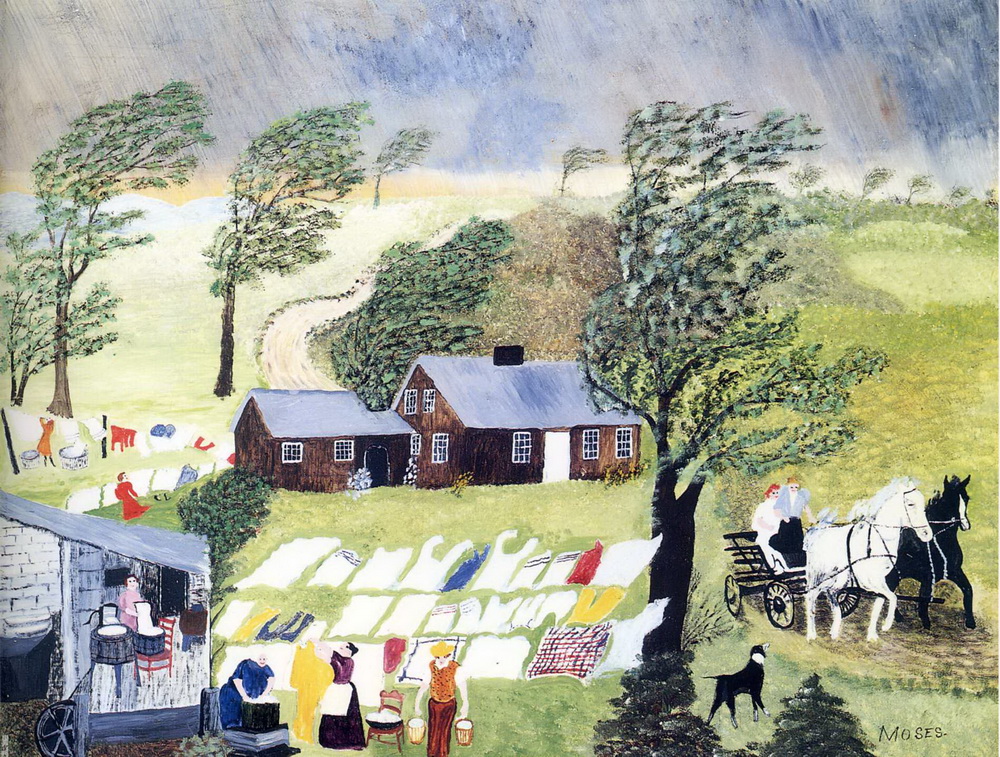
Original Size
(25)Catching the Turkey. Naïve Art (Primitivism).
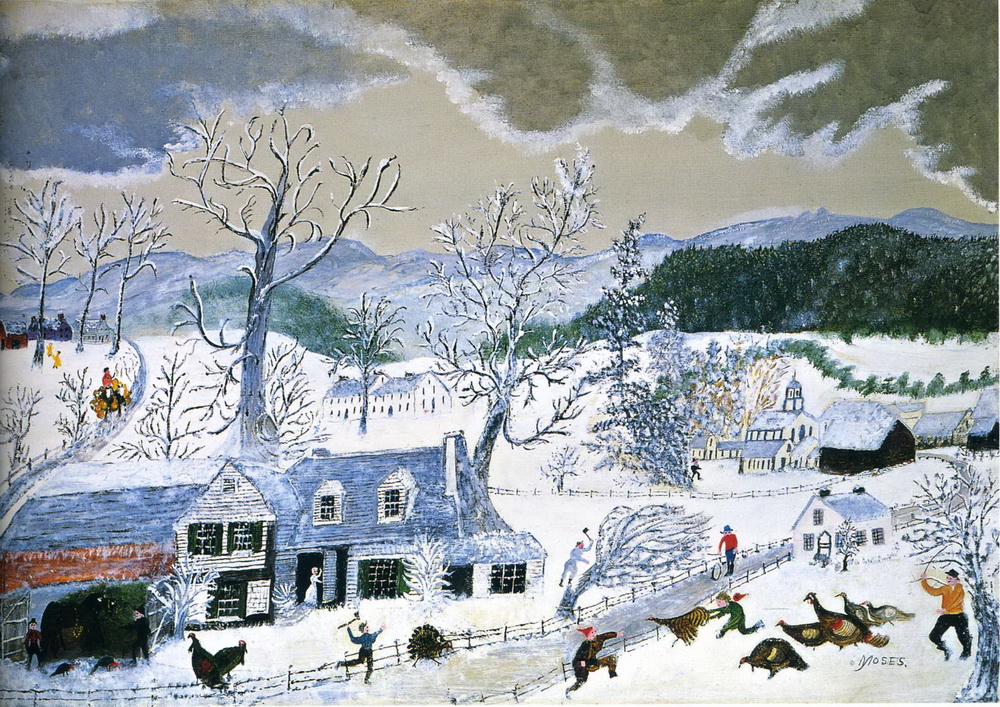
Original Size
(26)A Beautiful World, 1948. Naïve Art (Primitivism).
A the title suggests, A Beautiful World represents Grandma Moses& view of ideal harmony between humankind and nature.
"I like pretty things the best, Moses once told an interviewer. "What&s the use of painting a picture if it isn&t something nice? So I think real hard till I think of something real pretty, and then I paint it. I like to paint old-time) things, historical landmarks of long ago, bridges, mills, and hostelries, those old-time homes, there are a few left, and they are going fast. I do them all from memory, most of them are daydreams, as it were.
So much twentieth-century painting has been difficult and pessimistic that some have a tendency to dismiss Moses vision as simplistic. In fact, though, there has been much art throughout history that is accessible and optimistic. All art is in some sense an affirmation of life—an offering of the human spirit, however downtrodden, as proof that our thoughts and feelings are ever precious and sometimes beautiful. This is the essence of Grandma Moses& genius.

(27)Apple Butter Making, Start Date: 1944, Completion Date: 1947. Naïve Art (Primitivism).
Although many people think of apples as a New England commodity, J. A. Apple Butter Making is actually among a handful of paintings based on Moses& Virginia memories. The house in the picture is the Dudley Place, one of several farms the Moses family occupied as tenants during their years down South.
"Late summer was the time for apple butter making," Moses wrote in her autobiography. "The apple butter was considered a necessity."
To make apple butter, you take two barrels of sweet cider {you grind apples and make sweet cider first), then you put them on in a big brass kettle over afire out in the orchard and start it to boiling. You want three barrels of quartered apples, or snits, as they called them, with cores taken out, and then you commence to feed those in, and stirring and keeping that stirrer going. . . . Womenfolks would keep that going, feeding in all the apples until evening. Then the young folks would come in to start stirring. They&d have two—a boy and a girl—to take hold of the handle. They&d have a regular frolic all night out in the orchard.
Moses& personal recollections—parts of which read like recipes, others like social history—were mirrored in the content of her painting.

(28)The Thunderstorm, 1948. Naïve Art (Primitivism).
The Thunderstorm poignantly illustrates how Grandma Moses managed to combine intensely evocative renditions of natural phenomena with dramatic anecdotal detail.
There are several levels of action in The Thunderstorm. Fierce storm clouds arc rapidly approaching over the mountains, and in the distance the trees have already begun to whip wildly in the wind. The artist&s deployment of color to represent these events is extraordinarily acute: The parched yellows of a late summer meadow, the varied greens of the trees, and the shifting colors of the sky before the advancing torrent are all keenly observed.
In the foreground, Moses presents the human reaction to the oncoming threat. There is a mad rush to get the hay into the barn and, at middle distance, a black horse bolts in terror.
The girl in the yellow dress is frozen in mid-run, while strangely, behind her to the left, two other children seem oblivious to the commotion. The abstract forms used to render all the human and animal activity stand in sharp contrast to the impressionistic interplay of colors in the landscape elements of the composition. This juxtaposition of abstraction and realism was one of the principal cornerstones of the "Grandma Moses style."

(29)Checkered House. Naïve Art (Primitivism).
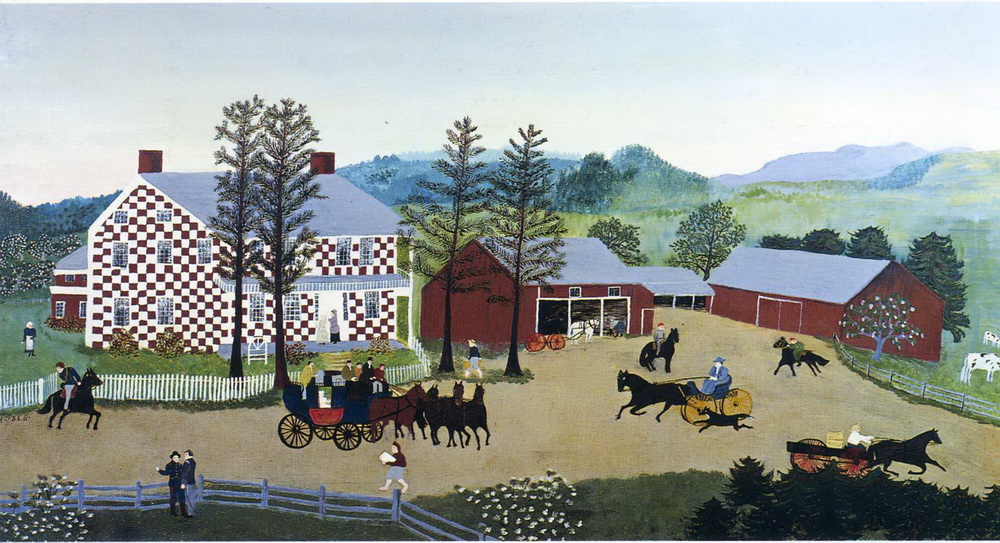
Original Size
(30)Plow Boy, 1950. Naïve Art (Primitivism).
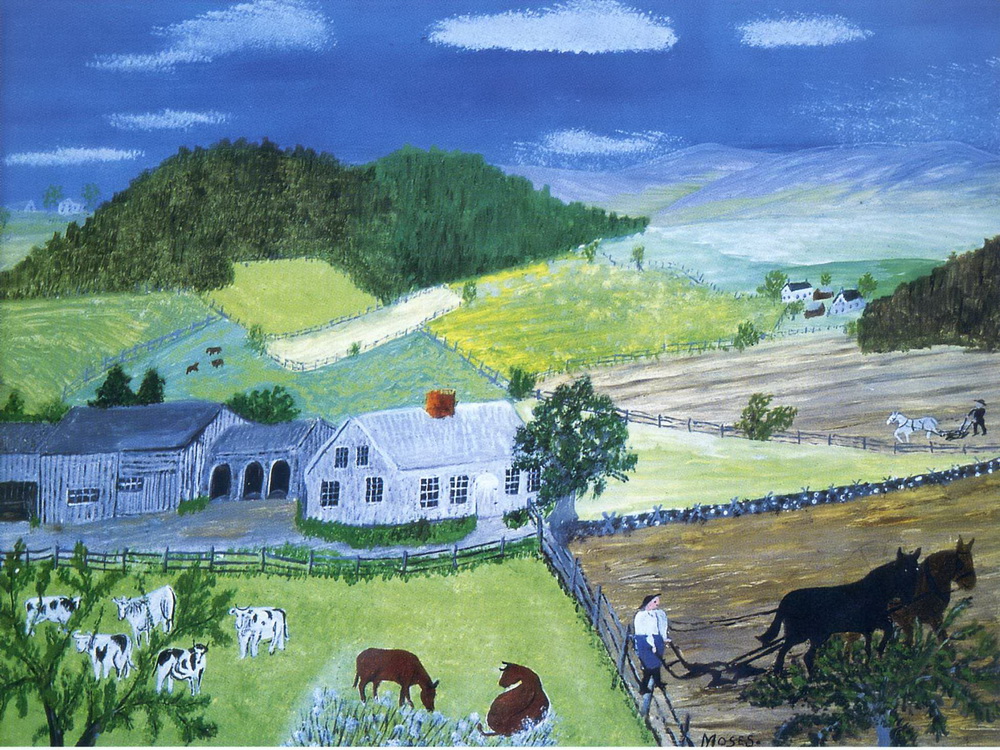
Original Size
(31)The Spring in Evening, 1947. Naïve Art (Primitivism).
While Moses& way of piecing together compositions was partly dictated by her sense of abstract design, the arrangements were always subordinated to the requirements of the landscape. As a substitute for academic perspective (which she had never learned), she had recourse not just to a progressive scheme of diminishing sizes, but also to coloristic indicators of space. She was quick to note such qualities as the pale blue of distant hills, or the tonal gradations of the sky. She translated phenomena observed from nature into veils of color and layers of pigment.
The Spring in Evening is notable for the way in which Moses captured both time of year and time of day. The rawness of the freshly plowed earth, the new growth on the hillside, and the lambent pink of the sunset are all rendered with a sure feel for color and a striking verisimilitude. Variations in the physical and tonal density of the paint create a series of transitions between the artist s anecdotal vignettes and the more complex hues of the landscape. The bold silhouette of the horses and the houses are spare, formal essences embedded in a network of paint. It is, however, the natural landscape that brings the whole to life.



